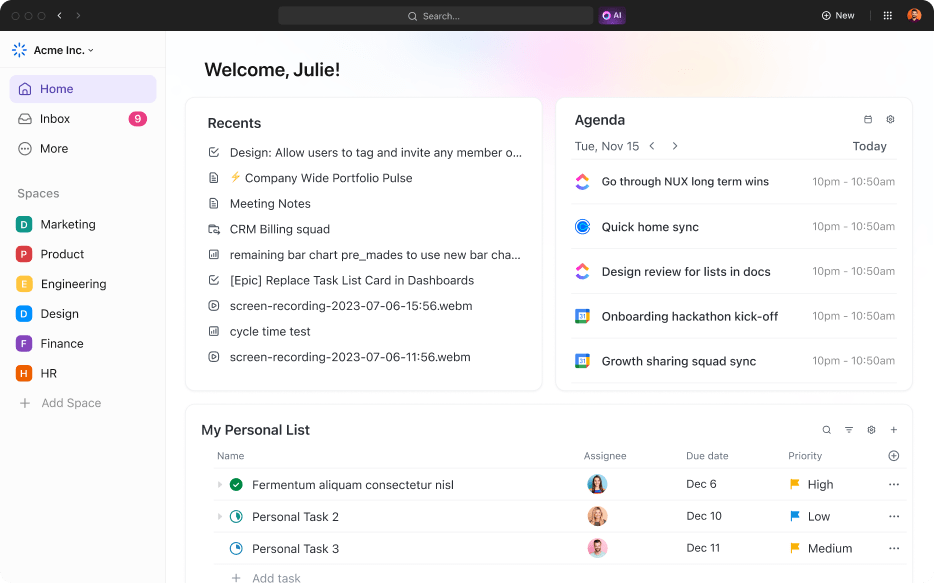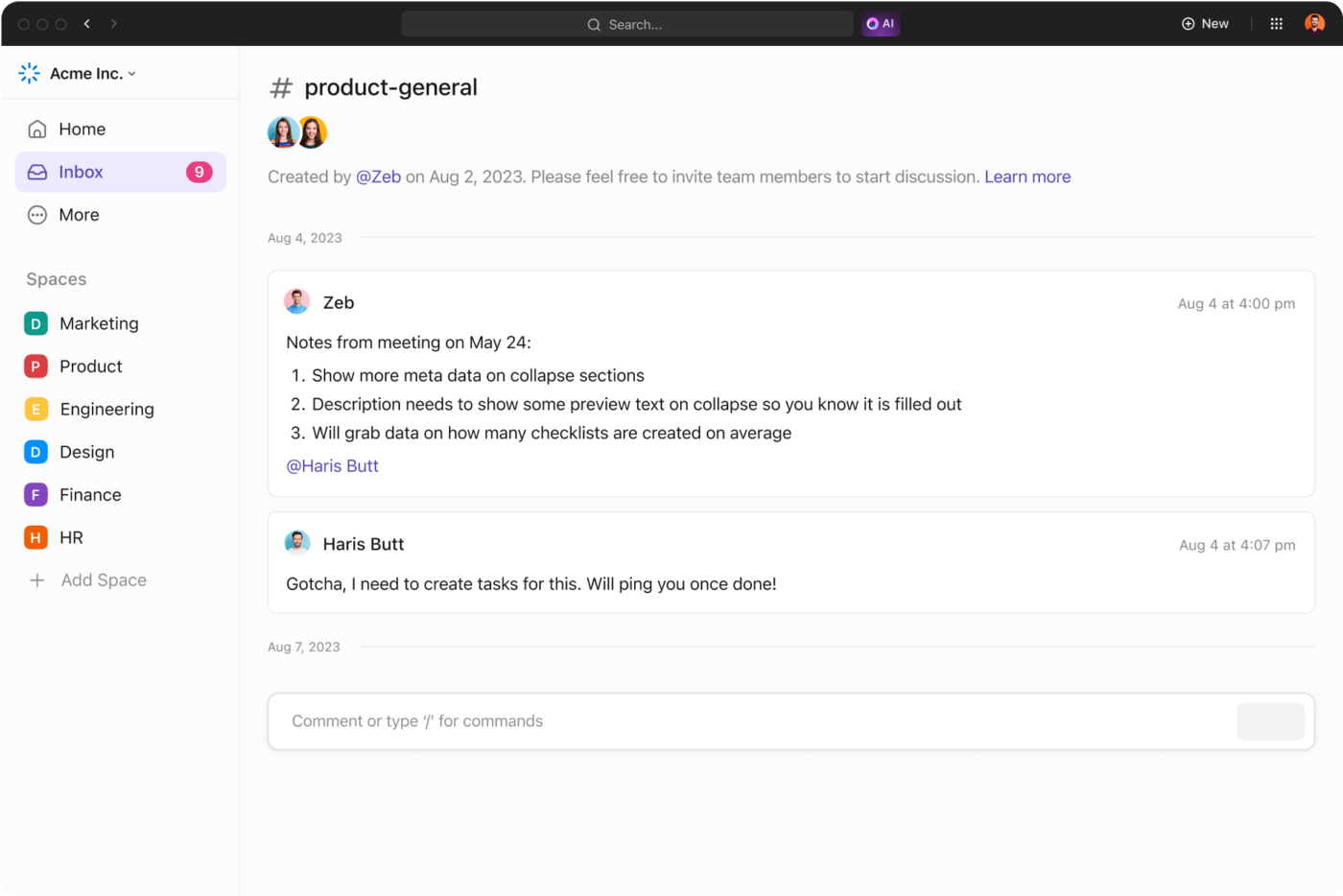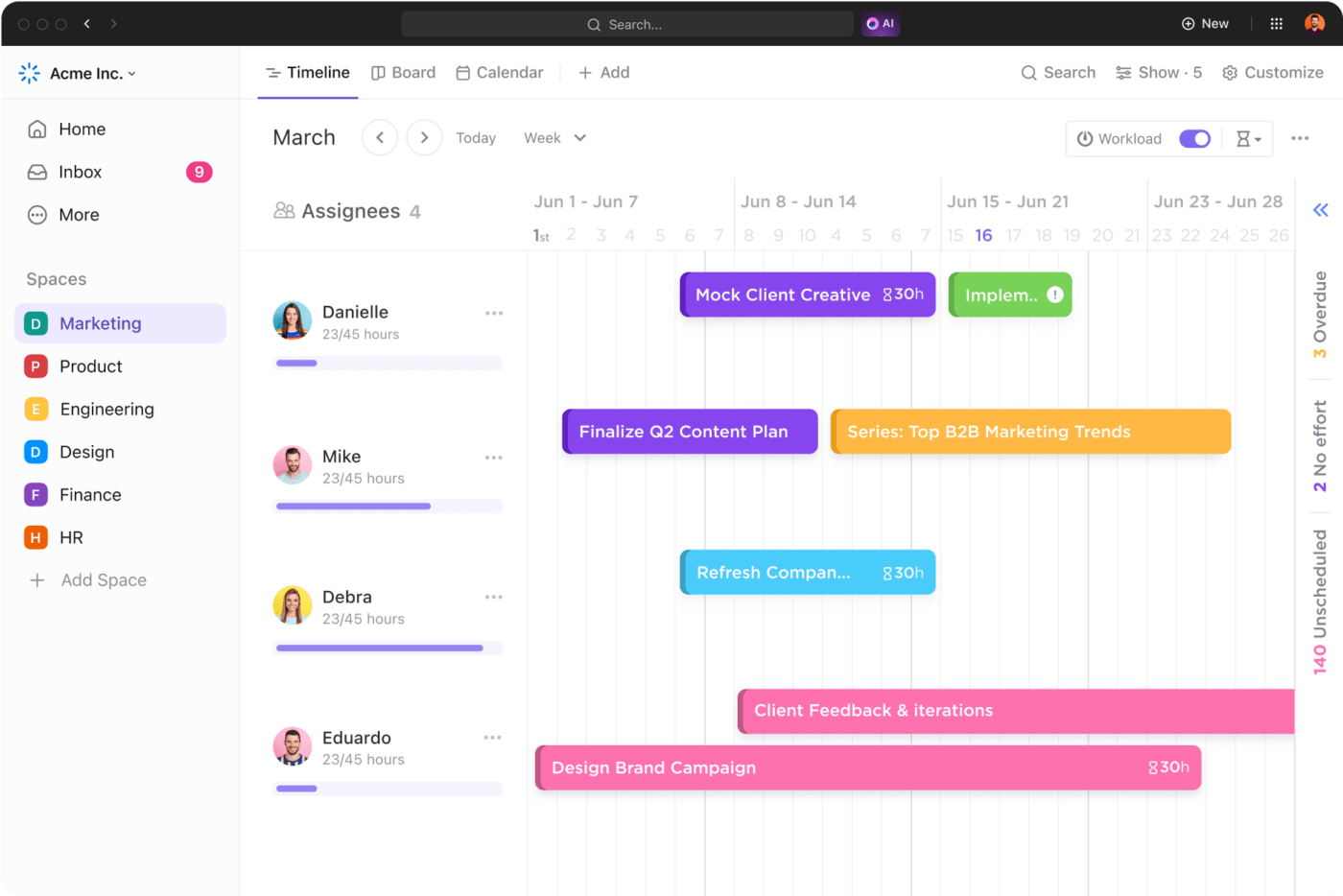

While management styles may vary greatly, most successful business leaders agree that an organization’s greatest assets are its people. 🧑🏼🤝🧑🏽
But if you hire the best, empowering them to bring their best selves to work makes sense. Increasingly, management gurus have turned to self-management to build independent, self-motivated, productive, and highly creative teams.
As the name suggests, unlike traditional teams, self-managed teams work autonomously without direct supervision, though they may still report to a supervisor or team leader when needed. Organizations rely on self-managed individuals to do their jobs well without micromanagement.
And with the help of tools like ClickUp for Teams, self-managed work teams can flourish as they drive organizational growth.
In this blog post, we’ll take a deep dive into this management style to see how you can build self-managed teams in your organization.
- Understanding Self-Managed Teams
- Key Characteristics of Self-Managed Teams
- Pros and Cons of Self-Managed Teams
- Building a Successful Self-Managed Team: A Step-by-Step Guide
- Define self-managed teams
- Look out for signs
- Identify interested team members
- Set clear goals and objectives
- Develop team roles and responsibilities
- Allocate and track tasks
- Open channels for communication
- Establish decision-making mechanisms
- Provide resources
- Set result-based timelines
- Assess the effectiveness of your self-managed team
- Help Your Self-Managed Teams Thrive
Understanding Self-Managed Teams
Unlike a traditional project or agile team headed by a more conventional manager or supervisor, a self-managed team is typically a small, self-directed unit without a traditional hierarchical or top-down organizational structure.
All team members own their goals, tasks, and responsibilities to drive outcomes.
There’s no hierarchy within a self-managed team. Instead, team members discuss the scope and limits of each others’ responsibilities and are empowered to make decisions within those areas. As a result, each person can manage their workload how they see fit.
Since every process and output is discussed within the team before they reach a final consensus, self-managed teams are ‘semi-autonomous.’ Power is decentralized, and overall accountability is shared.
Self-governance is a key concept at play here. Every self-managed individual is responsible for both their individual performance and the overall business goal. And though they must operate within the guidelines for a specific project, they are free to work in the way that best suits them.
This also means that some self-managed teams enjoy unlimited time off. They can take vacation days or abbreviated workdays as long as the project progresses as planned. Expectedly, successful self-managed teams are built on a strong foundation of trust and ownership.
Key Characteristics of Self-Managed Teams
Self-managed teams have emerged as a powerful force, driving innovation, fostering creativity, and enhancing organizational culture through greater employee engagement. To fully understand the essence of self-managed teams, let’s look at the defining characteristics distinguishing them from more traditional management teams.
1. Autonomy
In a self-managed team, autonomy takes center stage. Team members of these fully autonomous teams can make decisions about their work, prioritize tasks, and solve problems without constant supervision.
This delegation of power enables a sense of ownership, balancing autonomy and responsibility among the entire team, driving them to take initiative and find creative solutions.
Autonomy is also characterized by:
- Informed decision-making power: Equip your team with knowledge and expertise to make informed decisions aligned with team goals
- Effective time management: Give your team autonomy over their schedules, allowing them to optimize productivity and minimize distractions
- Creative problem-solving: Empower team members to brainstorm solutions independently and enable a culture of innovation and effective problem-solving
2. Collaboration
Self-managed teams excel at collaboration. The team has self-motivation and works together to share ideas, solve problems, and achieve common goals. This collaborative approach of a self-managing team can lead to more creative solutions, strong communication, improved efficiency, and a stronger sense of team spirit.
Effective collaboration results in
- Mutual respect: Encourage the team to value and respect each other’s contributions for better outcomes
- Active listening: Ensure everyone’s ideas are heard and considered through active listening
- Shared decision-making: Collaborate as a team to make decisions using collective expertise and insights
3. Ownership
Self-managed teams are driven by a strong sense of ownership, where team members take pride in their work and feel a personal stake in the project’s or team’s success or failure. This ownership increases motivation, better decision-making, and a heightened commitment to delivering high-quality results.
Benefits of ownership include:
- Increased productivity and performance: When team members have full ownership of their work, they are intrinsically motivated to perform well and increase productivity
- Reduced reliance on managers: Such teams don’t need managers for day-to-day tasks, as they manage themselves.
- Improved decision-making: Teams that take responsibility for their outcomes actively collect information to make better decisions, and have a problem-solving approach to work
4. Accountability
Accountability is a cornerstone of self-managed teams. Team members are collectively responsible for their contributions and the team’s overall project success. This shared accountability drives individuals to perform their best and ensures the entire team stays focused on achieving its goals.
Accountability results in:
- Individual responsibility: Team members hold themselves accountable for their individual performance as well as team outcomes
- Improved team performance: Team members also hold each other accountable to achieve better results
- Reduced conflict: Shared responsibilities prevent tension from escalating and enable effective conflict resolution
5. Continuous improvement
Successful self-managed teams thrive on continuous improvement. Team members are encouraged to learn, grow, and adapt to challenges. This commitment to improvement drives the self-directed team to seek new working methods, refine processes, and deliver exceptional results.
Continuous improvement leads to:
- Increased efficiency: Consistently identifying and eliminating processes, workflows, and products that create inefficiency improves productivity
- Improved customer satisfaction: Continuous improvement of processes and practices helps the organization provide better products and services to customers
Pros and Cons of Self-Managed Teams
Just as every management model has its flipside, self-managed teams have pros and cons too.
Pros of self-managed teams
Building self-managed teams has several advantages, such as high productivity and motivation, quick decision-making, and cost savings. Let’s break this down.
Improved productivity and skills
Self-managed teams are typically far more productive than traditional ones. Because ownership and accountability factor so heavily in self-managed units, they usually work harder than traditionally structured teams. They may even acquire new skills to ensure they remain worthy of the ‘self-managed’ tag.
Thus, self-managed individuals tend to develop stronger discipline in their jobs.
Enhanced motivation and engagement
The team’s performance reflects its efforts, so employees feel more motivated to put their best foot forward. Working toward a shared goal while owning specific tasks also improves morale and motivation. Being in a successful self-managed team makes employees feel more empowered and pushes them to give their best to the project.
Improved decision-making
Self-managed teams are self-reliant. Their laser focus on the outcome of a project means they tend to make well-informed, collaborative decisions, even on complex matters.
Increased efficiency
Self-managed teams operate in a lean hierarchy, with no middle management layer between them and leadership. This reduces the possibility of miscommunication, increases autonomous decision-making, and allows for fast and collaborative action.
Higher cost-effectiveness
With self-managed teams, organizations save the cost of hiring, training, and retaining managers and supervisors. In addition, as such teams tend to be more efficient and productive, they save time and money and help the entire organization generate higher profits.
Cons of self-managed teams
It’s not always sunny in the world of self-management. Here are some disadvantages to self-managed teams.
Conflicts and differences of opinion
Diversity is a boon for organizations. But when people come from different backgrounds and areas of expertise, they are bound to have different perspectives. In the decentralized world of self-managed teams, differences in opinion can slow down decision-making and potentially create conflicts.
Employees need to be trained to handle these differences tactfully and productively.
Accountability versus autonomy
Complete autonomy, in the wrong hands, can incur a steep cost. So, self-managed teams (and individual members) must be fully accountable for their performance and outcomes.
In such small and focused teams, if even a single team member abuses their autonomy, it impacts the whole team. Projects don’t go as planned, and organizations incur losses. This is a significant risk when it comes to self-managed teams.
Potential for loss of direction
Building self-managed teams requires time and careful thought. Selected employees might not be the right fit for self-management, which could hinder team performance. Also, if the right guidance and proper training are not provided to the self-directed team initially, it could quickly lose direction.
Building a Successful Self-Managed Team: A Step-by-Step Guide
Self-managed teams can unlock the floodgates of productivity and innovation for your company. But it has to be done right.
Here’s a step-by-step guide on how to build high-performing, resilient, self-managed teams.
Define self-managed teams
First, define what a ‘self-managed team’ means to you. Are you looking for a semi or fully autonomous team? Does it include people with specific skill sets, for instance, problem-solving skills? Do you want to develop autonomous teams for products or services or another specific task?
Determine what definition of self-directed teams works best for your organization, both functionally and culturally. Then, follow the next steps to create a high-performing, self-managed work team.
Look out for signs
The next logical step in implementing self-managed teams is to gauge if your employees show any of the above mentioned characteristics or traits. Recall that an ideal self-managed team consists of people who are self-driven, trustworthy, confident in decision-making, great at time management, and strong communicators.
Identify interested team members
Once you’ve evaluated candidates who’d be perfect in self-managed roles, ask them if they’re interested. Not everyone may be. Irrespective of ability, many employees might rather have a manager to guide and direct them.
It’s important to seek out individuals who are keen to upskill and improve constantly and are confident enough to handle problems independently. The possible team members must also possess the interpersonal skills to work well in a team of similarly independent-minded individuals.
You can use various team-building techniques to ensure your self-managed team members gel well.
Set clear goals and objectives
Next, define the goals and objectives you want your self-managed team to achieve. Lay out the expected output and outcomes clearly so the team knows what they’re working toward. Also, explain how you’ll be measuring these outcomes.
The best practice is to create achievable goals by using ClickUp Goals and assigning them to the relevant people. You can also set up channels to measure productivity.

Now that you’ve laid a clear roadmap of your expectations and mission strategy, plan to evaluate your team’s performance too. ClickUp’s Performance Reviews template will help you do that.
Conduct self-appraisals and give feedback with the help of this template.
Develop team roles and responsibilities
Assign clear roles and responsibilities to the self-managing teams. Make it clear that each member is on a lateral hierarchy scale rather than top-down on a traditional team structure. As a backup, create a mechanism allowing an external leader or others to chip in when an employee fails to complete their work.
Allocate and track tasks
Now that the groundwork is done, it’s time to allocate tasks to individual team members and the team as a whole. Efficient task management using tools like ClickUp Tasks can significantly improve team productivity.

Again, though the project team will work independently once they begin, you can still track their progress using ClickUp’s project management tool. This tool provides an overview of priorities, cross-team work, and project progress.

Open channels for communication
Create fixed channels for communication, such as stand-up meetings, discussion forums, weekly or monthly video calls, or whatever else works best.
ClickUp Chat offers a breakthrough in reliable and real-time team communication. You can integrate 1,000+ tools and apps on ClickUp to ensure seamless and precise communication.

Establish decision-making mechanisms
In a disciplined, self-directed team, no employee is vested with more authority than the other. This departure from a traditional management hierarchy can sometimes hinder the decision-making process.
To overcome this, you can appoint someone as a ‘facilitator,’ or the team can elect a facilitator. A facilitator serves as a mediator who runs meetings, manages conflict, and ensures overall consensus.
Provide resources

Provide training and empower your team with the tools they need to succeed. This could be a monetary amount disbursed during the initial setup, software for managing and tracking work, or full access to a repository of tools they can use as required.
ClickUp Templates are great for self-driven teams to pick and choose what they need to function. You can find templates for project management from SWOT analysis and SIPOC (suppliers, inputs, process, outputs, customers) frameworks. Teams can use these templates to plan, strategize, execute, allocate, and measure their work.
Set result-based timelines

As modern businesses, we’re all working against the clock. Set clear, realistic deadlines that allow for contingencies while keeping team members on their toes and accomplishing goals. Since you’ve already clearly defined what constitutes success, ensure your self-driven team achieves what they set out to within the required time frame.
Assess the effectiveness of your self-managed team
Finally, take a long, hard look at the data once your project ends. Closely analyzing the metrics of a project executed by a self-managed team will help you make the required changes, whether those have to do with the team itself, the nature of the tasks, the resources provided, etc.
Keep improving with every iteration.
Help Your Self-Managed Teams Thrive
Setting up a self-managed team can be tricky. It needs careful planning, a strong understanding of the risks and advantages, and, most importantly, selecting the right people.
ClickUp’s convenient integration with 1,000+ tools, easy-to-use templates, automated workflows, and intuitive dashboards simplify planning, strategy, and execution for your self-managed teams.
Get closer to your productivity and efficiency goals with detailed analytics, privacy controls, and the freedom to link your favorite project tools.




